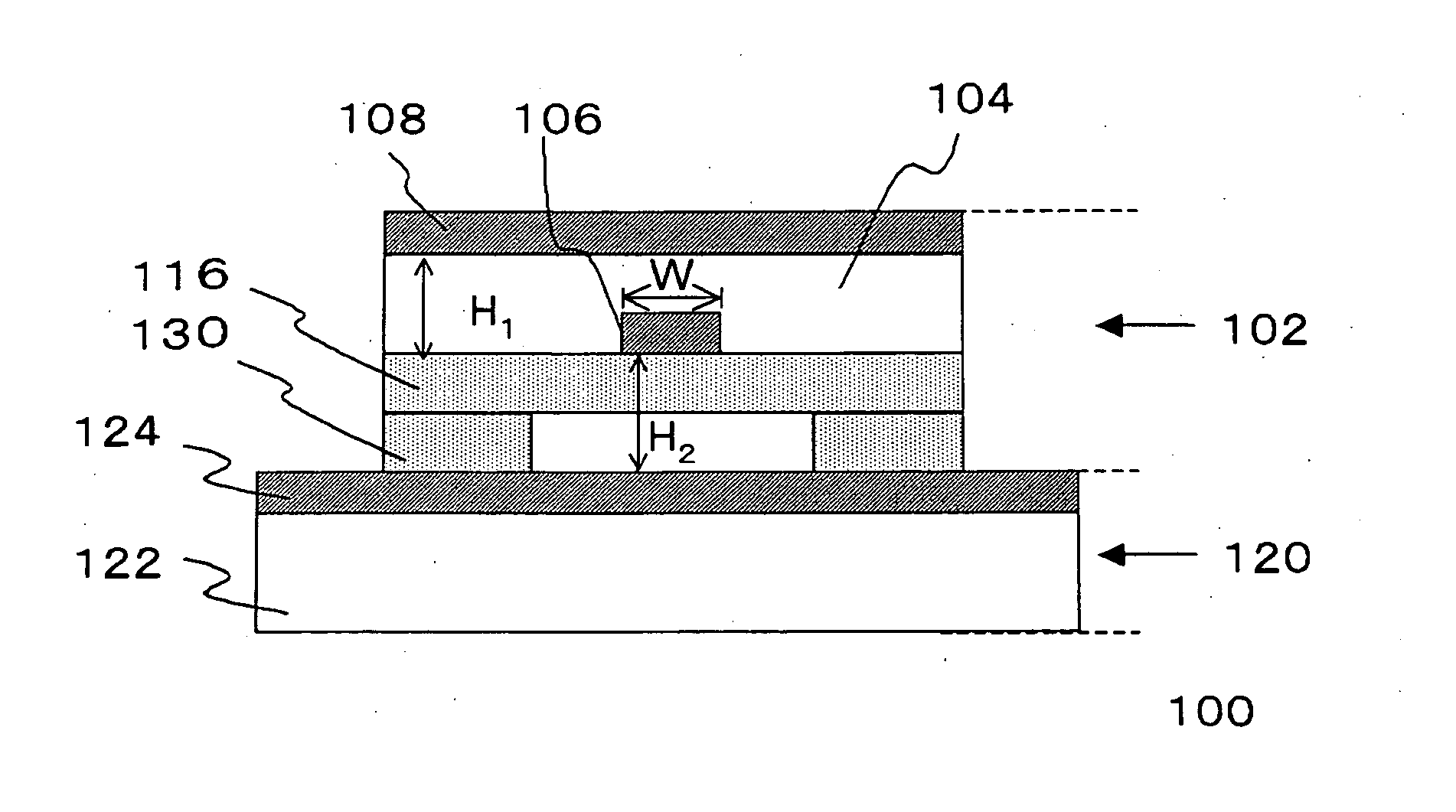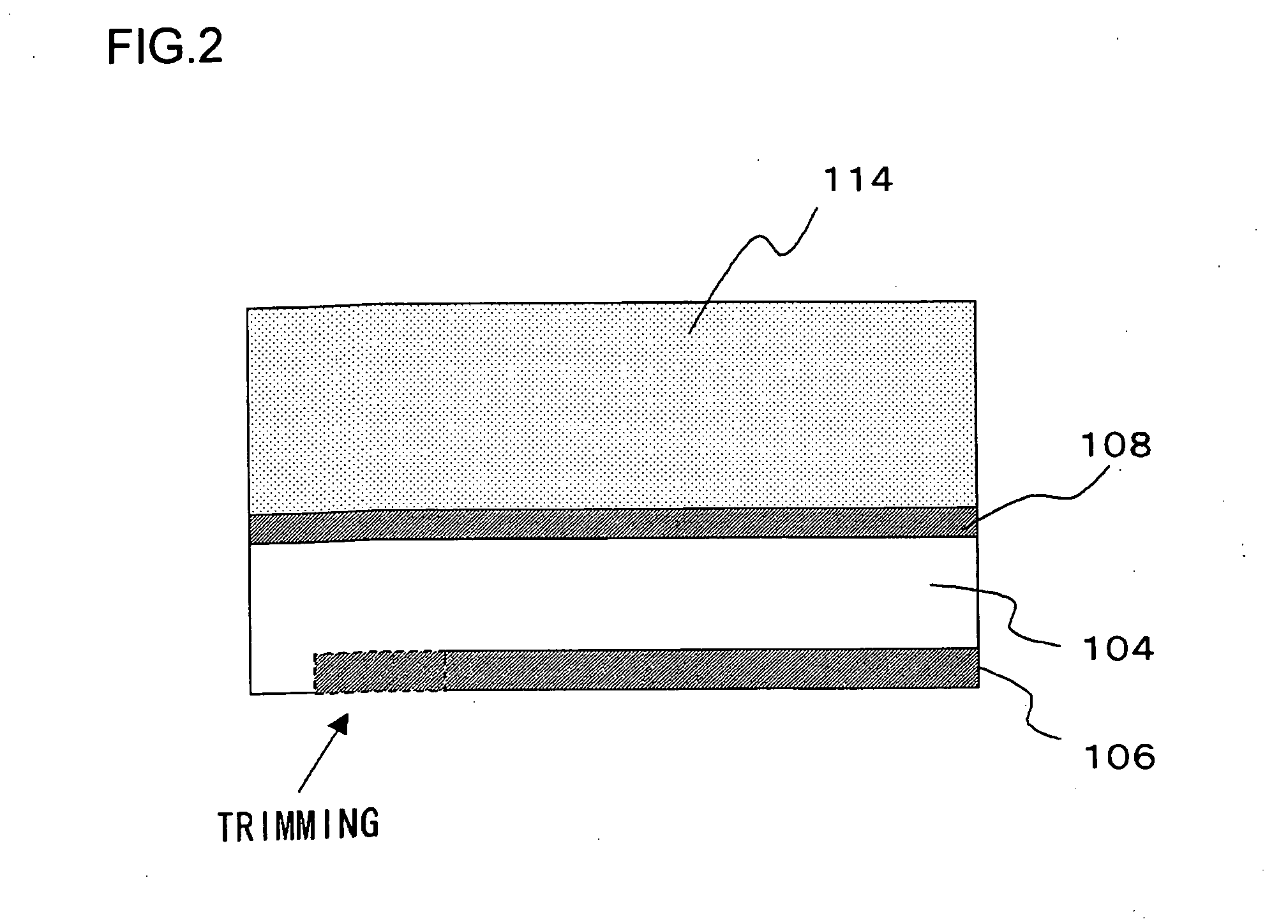Signal line circuit device
a circuit device and signal line technology, applied in the direction of waveguides, high frequency circuit adaptations, addition of non-printed jumper connections, etc., can solve the problem of prone to fluctuations in the character of the signal line, and achieve the effect of adjusting the device characteristics
- Summary
- Abstract
- Description
- Claims
- Application Information
AI Technical Summary
Benefits of technology
Problems solved by technology
Method used
Image
Examples
first embodiment
[0044]FIG. 1 is a diagram showing the layout of the peripheral circuits when a signal line circuit device according to a first embodiment of the present invention is used as one component of an amplifier.
[0045] In the diagram, the amplifier 201 comprises an input circuit 200, a transistor 202, a coil 204, a signal line circuit device 102, and an output circuit 206. The input circuit 200 is connected to the base of the transistor 202, and the output circuit 206 is connected to the collector. Furthermore, the coil 204 and the signal line circuit device 102 are also connected to the collector of the transistor 202. The emitter of the transistor 202 is grounded. A detailed description of the signal line circuit device 102 is presented below, but in brief, the signal line circuit device 102 is a microstrip line comprising a signal line and a ground line. The characteristics of the amplifier 201 fluctuate depending on the characteristics of the transistor 202 and the coil 204, but by adj...
second embodiment
[0085] One aspect of a second embodiment of the present invention is a wiring board in which a signal line is formed on one surface of a dielectric substrate and a ground conductor is formed on the other surface, wherein the wiring board also comprises a coating layer which covers the signal line and a sealing layer which seals the signal line, and wherein the dielectric substrate is formed from a resin material, and the dielectric loss tangent for the coating layer is smaller than that for the sealing layer.
[0086] By adopting such a structure, the electromagnetic field of the signal line is confined within the coating layer, meaning the strength of the electromagnetic field that leaks out into the sealing layer, or even outside the wiring board, is reduced. As a result, the electrostatic capacity of the sealing layer is reduced, enabling suppression of the dielectric loss that occurs within the sealing layer, and suppression of the radiation loss. Furthermore, because a material w...
example 1
[0105] The example 1 used the layer structure shown in FIG. 15, wherein the line width W of the signal line 1030 was 180 μm, and the line conductor thickness t was 25 μm. The dielectric substrate 1020 was formed from a liquid crystal polymer, with a relative dielectric constant of 2.85, a dielectric loss tangent of 0.0025, and a thickness H of 100 μm. The coating layer 1050 was formed from a polyimide, with a relative dielectric constant of 3.9, a dielectric loss tangent of 0.0036, and a thickness tc of 40 μm. The sealing layer 1060 was formed from an epoxy resin, with a relative dielectric constant of 3.6, a dielectric loss tangent of 0.006, and a thickness of 650 μm. Hence, in this example 1, the dielectric loss tangent of the coating layer 1050 was smaller than the dielectric loss tangent of the sealing layer 1060. Furthermore, the relative dielectric constant of the coating layer 1050 was larger than the relative dielectric constant of the sealing layer 1060.
PUM
 Login to View More
Login to View More Abstract
Description
Claims
Application Information
 Login to View More
Login to View More - R&D
- Intellectual Property
- Life Sciences
- Materials
- Tech Scout
- Unparalleled Data Quality
- Higher Quality Content
- 60% Fewer Hallucinations
Browse by: Latest US Patents, China's latest patents, Technical Efficacy Thesaurus, Application Domain, Technology Topic, Popular Technical Reports.
© 2025 PatSnap. All rights reserved.Legal|Privacy policy|Modern Slavery Act Transparency Statement|Sitemap|About US| Contact US: help@patsnap.com



